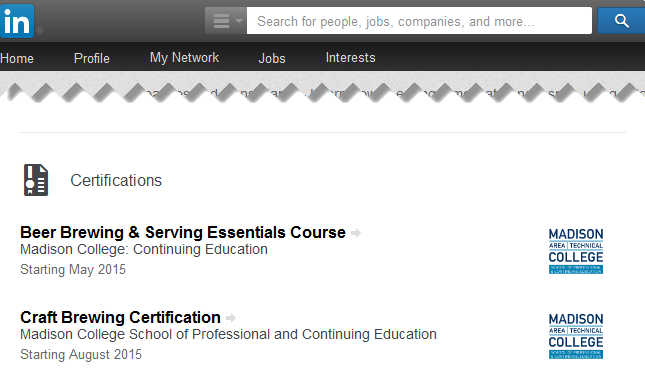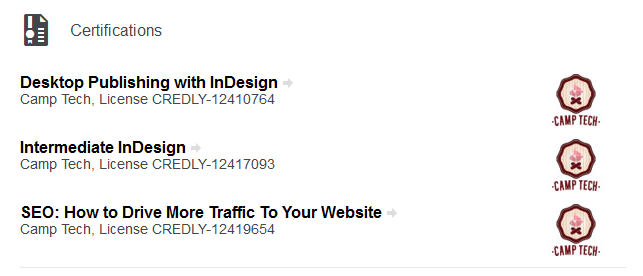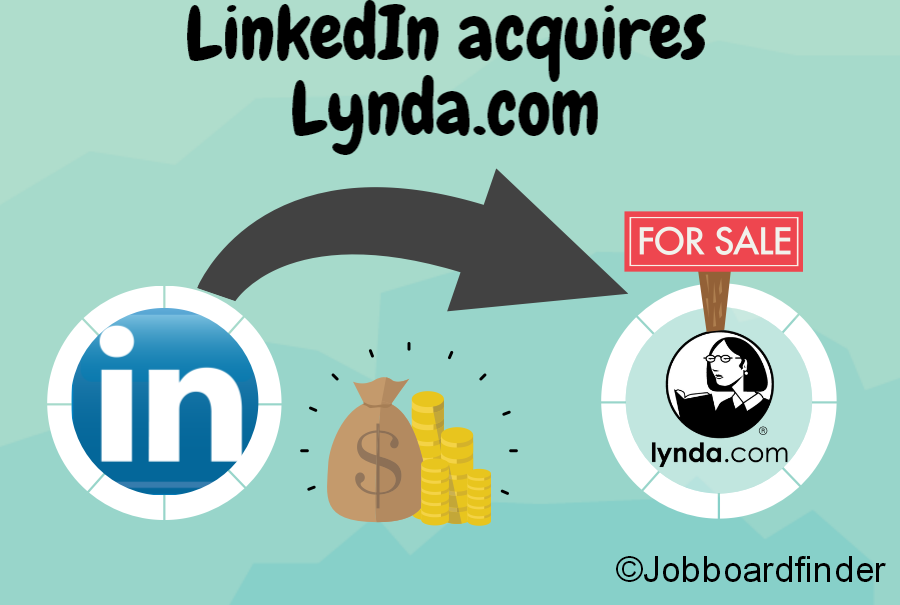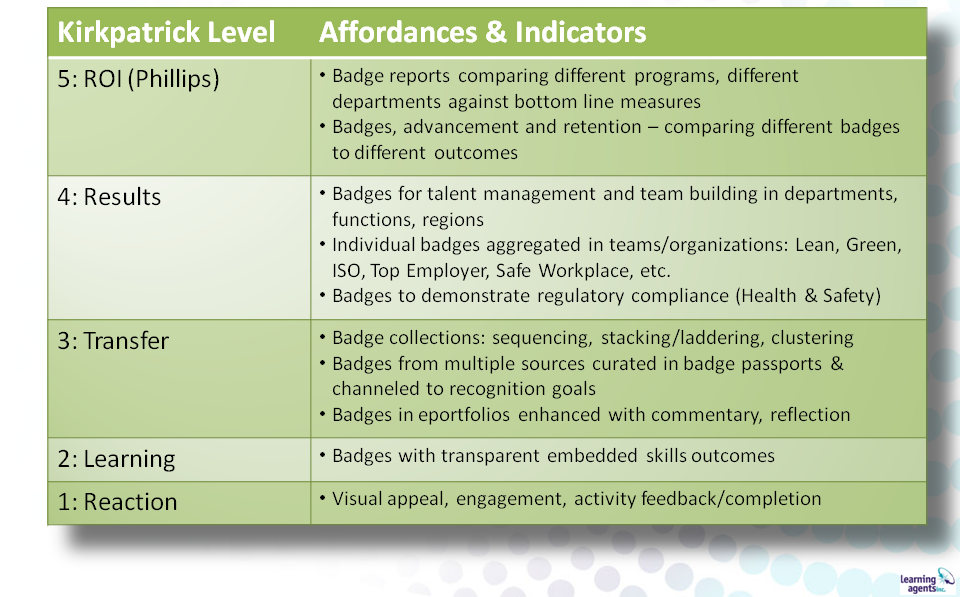This post goes out to a significant group of potential early adopters of eCredentialing with Open Badges: the entrepreneurs in the education and training community. I mean departments or organizations who are explicitly in the business of selling learning opportunities, especially in smaller chunks, such as:
- Professional and Continuing Education (PACE) and Extension functions in colleges and universities
These profit units compete with each other and the private sector in providing learning opportunities primarily to adults tweaking their careers and professionals maintaining their currency. - Contract Training initiatives
These trainers want to increase the transferable value of their custom programs by aligning them to skills frameworks, development pathways and certifications. Often part of the ConEd function in colleges and universities, contract trainers can also be private sector organizations, from large consulting firms down to independent trainers. - Independent Trainers
These small to medium-sized operators compete with the above and are often seeking more profile and brand footprint, along with better ways to communicate the quality, impact and transferability of their programs. Unlike their institutional competitors, they often don’t have the the advantage of formal accreditation. They want to boost their “gravitas”. - Product Support Trainers
Product training increases customer retention and is often another revenue stream for private sector companies. There’s lots of early traction in the ICT hardware and software sectors, but other types of products also have great potential: vehicles, pharmaceuticals, food processing, etc.
Early evidence suggests that product training and its impact on revenue will be the “sharp end” of Open Badges adoption in the private sector, rather than workforce development, with some notable exceptions, such as the Scottish Social Services Council.
All of these groups can benefit from early adoption of eCredentials powered by Mozilla Open Badges.
Note to the committed Open Badges community
Granted, what I’m talking about here is not the core of the original Mozilla dream of Open Badges. But it is a leading edge for technology adoption that will help pull the whole into the mainstream. Once enough practical people see enough business benefit in Open Badges to pay for them and make them part of their business, then you start to have a diversity of sustainable business models that will help build the skills ecosystem that Mozilla did dream about, and help pull the more idealistic elements of the dream into the ecosystem, and build demand for all kinds of credentials.
This can happen without corrupting the original idea of an open skills ecosystem. People *can* make money providing products and services in open systems. That’s called the network effect. That’s called the Internet. That’s why Mark Surman of Mozilla compares Open Badges today to the early days of email. If we can manage even a part of that, we’ll be doing it long after the foundation funding dries up.
I’ll be talking more about the advantages and nuances of staying “open” in future posts.
Top 3 benefits of eCredentialing with Open Badges
1. Your learning is more granular and specific
Udacity showed us the way:
Other industry heavyweights such as IBM, Oracle and Adobe also are now using digital badges to recognize and certify specific “hard” in-demand skills such as:
- Big Data (“it’s so hot right now”)
- Java programming
- Multimedia product expertise
But there are also health and safety compliance examples out there such as annual WHMIS and HAACP certification, and I’m even starting to hear about training programs that credential pharmaceutical logistics skills, because of the bottom line importance of safe and efficient transportation of perishable pharmaceuticals through the supply chain.
Employers want to know the status of these important skills in their talent pipelines and existing workforces. eCredentials make this possible, and the Open Badge standard makes these eCredentials not only portable between systems but also machine readable, for “big data” analytics that can start measuring further up the Kirkpatrick ladder:
2. Your learning is more modular and progressive
How do you eat an elephant? One bite a a time. If you can break a longer certificate program down into bite-sized chunks, you may get more busy adults completing the program, even if they do have to drop it for a while and pick it up later.
Here’s a good illustration from Colorado State University’s Extension Gardener program, showing 3-level laddering (also known as stacking):

CSU Extension Certified Gardener Program
(See also the CSU case study on the Open Badges in Higher Education website.)
Another way to express this is that eCredentials such as Open Badges support Competency Based Education (also very hot right now. And employer friendly.)
3. Your learners promote your brand for you
The Continuing Education department at Madison Area Technical College in Wisconsin is a model early adopter of digital badges and is already reaping the benefits on social media such as LinkedIn:

(See this recent Slideshare presentation to learn more.)
But even small trainers up here in Canada are benefiting, such as Camp Tech, a technology skills training firm operating in Toronto, Ottawa and Vancouver:

and Roy Group, a Vancouver-based organizational leadership training specialist:

This last one is interesting. Roy Group was convinced to get into Open Badges by Sir John Daniel, formerly head of the Commonwealth of Learning, also based in BC. When they did, Sir John wrote Roy Group a letter of commendation for “demonstrating its own leadership by using Open Badges to recognize formally the skills and experience that its clients acquire.” They proudly display this letter on their website.
The top 5 issues and risks
So, with all these benefits, why aren’t more trainers using eCredentials to build their businesses?
1. Lack of awareness, business distractions
“Never heard of it before; interesting. But we have other, more pressing issues we have to attend to.”
Awareness is still an issue, but that’s starting to change. Certainly, if you don’t know about it, then you can’t do anything about it. Once you do know about it and can see the benefit, you may click with it right away if you’re an early majority type.
But if you’re a late majority type, you may need to see it applied specifically to your use case, maybe even in your market, perhaps by a competitor. (See “Lack of a burning platform” below.)
2. Reputation and brand
If we start handing out “badges” like stickers for kids or schwag at conferences it could make us look childish or trivial. Or we could screw it up other ways. This could damage our reputation as a quality institution.
It’s true, Open Badges are easy to do… badly. This can result from any combination of issues around vision, ignorance, hubris, governance, lack of planning, etc.
See Six Steps to Building High-Quality Open Digital Badges from the folks at the Center for Research on Learning and Technology, Indiana University for some hints on how to do it better. It’s also one of the ways I make a living while I try to make a difference: helping organizations build better badge systems.
3. Fear of unbundling the learning package
Our ability to credential learning is our key differentiator. Why would we want to cheapen that into a commodity?
OK, but we’re talking ConEd and work-related training here. A credential need not be a certification or a diploma in order to advance the learner’s career. Practical utility trumps rigour; private sector trainers already know this. It’s what they liked to call “fit for purpose” in the UK, before the term became over-exposed.
4. Confusion of concepts and terminology
We have digital badges in our courses; are they Open Badges? What’s the difference between a micro-credential and a nano-degree? How many credit hours in a badge? We need to figure this stuff out.
Rather than try to figure all this stuff out in advance, my advice is to pilot in low risk environments using whatever technology is available. Set up a low profile sandbox, immerse yourself exploring concepts and use cases, “fail early”, figure it out iteratively with your colleagues and trusted stakeholders and then go on from there. Many institutions are now at this exploratory stage.
If you try to work it all out in advance before you take your institution forward, you may end up looking like a conclave arguing about the number of angels on the head of a pin inside your castle while barbarian hordes and rival city states are hawking their wares outside your gates.
5. Lack of a “burning platform”
“Why bother with this? What’s the down side if we do nothing?”
Whatever the business, early adopters tend to be drawn by the prospect of new opportunities, whereas late adopters tend to respond to burning platforms, such as the threat of competition when it appears in their market. (Burning platform = a situation that forces you to jump – somewhere.)
LinkedIn seems to be one early adopter that can reach into a lot of markets:

According to Ken Steele in an Eduvation blog post in August 2015:
Excerpts from LinkedIn’s announcement video (https://youtu.be/W9jZPAomVvg ) make it clear that they want to manage profiles for every job, higher ed institution, company, and person in the global workforce. LinkedIn will then allow students to search for desirable jobs and employers, assess the skills required for any given position, and the best places to obtain those skills – including through LinkedIn’s online courses via Lynda.com.
Hmm…is this an opportunity or a burning platform?
NB: Join us to explore these ideas and more this fall in Bologna at ePIC 2016! Mairi Anne Macdonald of the Scottish Social Services Council is just one example of a stellar list of keynotes we’re assembling. She’ll talk about how they’re badging a 192,000 strong sectoral workforce with a focuson informal learning. Get your ePIC proposal in now!



